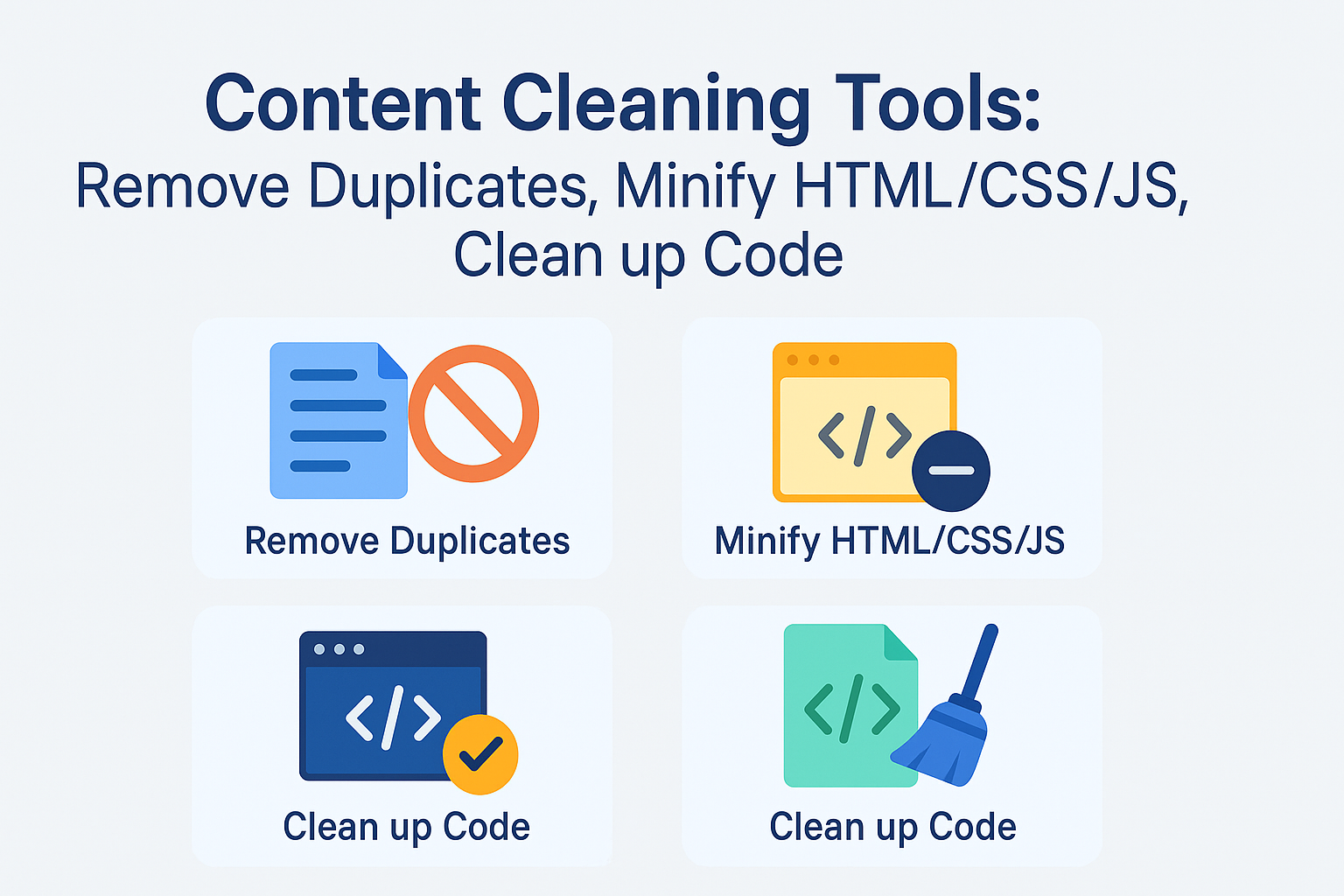
13
Content Cleaning Tools: Optimize Code & Performance
Discover the best content cleaning tools to remove duplicates, minify HTML/CSS/JS, and clean up messy code for faster websites.
Content Cleaning Tools: Remove Duplicates, Minify HTML/CSS/JS, Clean up Code
Introduction: Why Clean Content and Code Matter
In the fast-paced digital world, website performance is everything. A slow or messy site can lead to frustrated users, poor search rankings, and lost revenue.
Behind the scenes, duplicate content, bloated code, and unoptimized scripts often weigh websites down. That’s where content cleaning tools step in—helping you streamline your code, remove duplicates, and deliver lightning-fast pages that search engines love.
In this guide, you’ll learn:
- Why cleaning content and code matters for SEO and performance.
- The types of content cleaning tools available.
- Step-by-step methods to remove duplicates and minify code.
- The best tools for cleaning up HTML, CSS, and JavaScript.
Why Content Cleaning Tools Are Essential
Impact on SEO
- Duplicate content confuses search engines, leading to ranking penalties.
- Messy code slows down crawling and indexing.
- Unoptimized scripts affect Core Web Vitals scores.
Impact on User Experience
- Faster load times → Lower bounce rates.
- Clean layouts → Better readability.
- Efficient scripts → Smooth interactions.
Types of Content Cleaning
1. Duplicate Content Removal
Duplicate content occurs when the same content appears on multiple URLs. Search engines may penalize or ignore such pages.
Solutions:
- Canonical tags.
- Redirects.
- Duplicate content checkers.
2. Code Minification
Minification removes unnecessary spaces, comments, and formatting in HTML, CSS, and JavaScript without changing functionality.
Example (Before Minify):
body {
background-color: #fff;
font-size: 16px;
}
After Minify:
body{background-color:#fff;font-size:16px;}
3. Code Cleanup
Old or unused code (like CSS rules or JavaScript functions) bloats websites. Cleanup ensures only necessary code runs, improving efficiency.
Step-by-Step Guide: Cleaning Content and Code
Step 1: Identify Issues
Use tools like:
- Siteliner – Finds duplicate content.
- Google Search Console – Highlights indexation issues.
- PageSpeed Insights – Shows unused CSS/JS.
Step 2: Remove Duplicate Content
- Consolidate pages with similar content.
- Use 301 redirects to merge duplicates.
- Add canonical tags where necessary.
Step 3: Minify Code
Use online minifiers or build processes:
- HTML Minifiers: HTMLMinifier, Minify Code.
- CSS Minifiers: CSSNano, CleanCSS.
- JavaScript Minifiers: UglifyJS, Terser.
For WordPress users:
- Autoptimize or WP Rocket handle minification automatically.
Step 4: Clean Up Code
- Remove unused CSS with PurgeCSS.
- Use UnCSS or Chrome DevTools Coverage Tab to find redundant rules.
- Audit JavaScript with Lighthouse.
Step 5: Automate with Build Tools
For developers, integrate minification into workflows:
- Webpack – Automates minification and bundling.
- Gulp/Grunt – Task runners for cleaning and compressing code.
Best Tools for Content Cleaning
Duplicate Content Tools
- Siteliner – Finds duplicate content on your site.
- Copyscape – Detects plagiarism and duplicate text.
- Ahrefs Site Audit – Flags duplicate title tags and meta descriptions.
HTML/CSS/JS Minification Tools
- HTMLMinifier – Cleans up HTML files.
- CleanCSS – Online CSS minifier.
- Terser – Popular JavaScript minifier.
Code Cleanup Tools
- PurgeCSS – Removes unused CSS.
- Prettier – Formats and cleans code for readability.
- VS Code Extensions – Provide real-time linting and cleanup.
Real-World Example: Cleaning for SEO Success
A blog site struggled with slow load times due to unminified CSS and duplicate pages. After running a cleanup:
- Page load speed improved by 35%.
- Duplicate content reduced, boosting keyword rankings.
- Bounce rate dropped by 12% thanks to better user experience.
Advanced Tips for Developers
Use a CDN with Optimization
CDNs like Cloudflare and BunnyCDN automatically minify HTML, CSS, and JS on delivery.
Automate Duplicate Checks
Schedule monthly site audits with SEO tools (SEMrush, Ahrefs) to catch duplicates early.
Combine with Lazy Loading
Once code is cleaned, implement lazy loading for images and scripts to further improve speed.
Common Mistakes to Avoid
- Over-minifying: Stripping too much may break functionality. Always test after minification.
- Ignoring inline scripts/styles: They also need minification.
- Forgetting canonical tags: Without them, duplicates may persist.
- Not backing up code: Always keep a copy before cleaning or minifying.
The Future of Content Cleaning Tools
With Google’s focus on Core Web Vitals and user experience, code efficiency is more important than ever. Expect tools to evolve with:
- AI-powered duplicate detection.
- Automated unused code removal.
- Built-in optimization in CMS platforms.
Conclusion: Clean Code, Better SEO
Clean content and code are the foundation of a fast, SEO-friendly website. With the right content cleaning tools, you can:
- Remove duplicate content penalties.
- Minify HTML, CSS, and JavaScript for speed.
- Clean up unused code for efficiency.
Call to Action: Run a site audit today. Use cleaning tools to optimize your content and code—your users will stay longer, and search engines will reward you with higher rankings.
Contact
Missing something?
Feel free to request missing tools or give some feedback using our contact form.
Contact Us